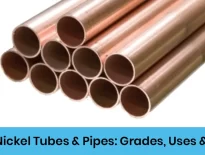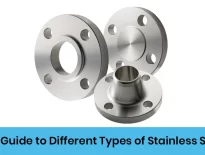Carbon steel flanges are essential components in piping systems, Since they provide secure connections across valves, pumps, and pipes and other devices, carbon steel flanges are vital components of pipelines systems. These flanges’ courage, durability, and affordability contribute to their usefulness throughout a number of industries.
We will examine several kinds of carbon steel flanges in this guide, including their characteristics, applications and prices. This comprehensive guide will help you with arriving at a smart decision if you’re looking for steel pipes made of carbon flanges, forged carbon steel flanges, or carbon steel flange fittings.
Types of Carbon Steel Flanges
1. Slip-On Flanges
Since they are affordable and easy to install, slip-on flanges are one of the most commonly used CS flanges. The pipe may slide into the flange before welding as their diameter is slightly larger than the linked pipe’s external diameter.
Features
- Ideal for applications requiring less force
- Both flat-face and raised-face patterns are offered.
- When properly welded, it delivers solid defense against leaks.
2. Weld Neck Flanges
The big tapered hub of a carbon steel weld neck flange strengthens the connection. Whenever structural integrity is essential, it is commonly used in high-temperature and high-temperature applications.
Features
- Its tapered hub lessens the concentration of stress
- Ideal for exceedingly high or low pressures and temperatures.
- ensures permanent and waterproof connections
3. Socket Weld Flanges
These flanges are created for high-pressure pipe networks having a smaller diameter. As they are just mechanically welded, they have a lesser likelihood of internal rusting or breaking.
Features
- Provides minimum disturbance and a smooth circulation of fluids.
- Ideal for pipes having high levels of pressure.
- needs precise fitting in order to be effectively welded.
4. Threaded Flanges
These types of flanges don’t need welding as they consist of threaded interiors which allow pipelines to be hammered in. Usually, they are used in circumstances where welding is difficult.
Features
- Easy to install and uninstall.
- Perfect for systems having low pressure.
- Utilized where welding is not recommended because of combustible or hazardous situations.
5. Lap Joint Flanges
A stub end with a backing flange comprise both separate parts of an overlap joint flange. They are often used in situations requiring regular dismantling.
Features
- Affordable replacement for weld neck flanges.
- Used in systems when the pipe diameter is significant.
- Perfect for circumstances demanding less exertion.
6. Blind Flanges
Pipe systems’ endpoints are closed with blind flanges. They are required for pipeline sealing, examination, and servicing.
Features
- Provides piping systems with secure finishing.
- Grades of steel made from carbon with high breaking strength are offered.
- Capable of withstand extreme pressures and temperatures.
Carbon Steel Flange Grades
Carbon steel flanges come in various grades, each suited for different applications based on strength, pressure requirements, and environmental conditions. Below are some of the commonly used carbon steel flange grades:
Carbon Steel A105 Flanges
Carbon Steel A105 Flanges are forged carbon steel piping components, i.e., they are used in fittings, flanges, valves, and similar parts as well as in pressure systems operating at ambient and elevated temperatures. Temperatures between 500 and 550 degrees are used to operate the carbon steel A105 flanges. This material is vital across a wide range of industries, including hydrocarbon, marine engineering, petrochemical, and nuclear power, as well as in the manufacture of heat exchangers, pumps, valves, and oil & gas equipment. Flanges come in a variety of forms, including blind flanges, weld neck flanges, plate flanges, and many more.
Chemical Composition of Carbon Steel A105 Flange
| ELEMENT | COMPOSITION, % |
| Carbon | 0.35 max |
| Manganese | 0.60-1.05 |
| Phosphorus | 0.035 max |
| Sulfur | 0.040 max |
| Silicon | 0.10-0.35 |
| Copper | 0.40 max (1) |
| Nickel | 0.40 max (1) |
| Chromium | 0.30 max (1-2) |
| Molybdenum | 0.12 max (1-2) |
| Vanadium | 0.08 max |
Mechanical Property of Carbon Steel A105 Flange
| Mechanical Properties | Requirements |
| Tensile strength | 70,000 – 100,000 psi |
| Yield strength | 30,000 psi (minimum) |
| Elongation | 20-25% |
| Reductionofarea | 30% min |
| Hardness | 85 HRB |
Carbon Steel A350 LF2 Flanges
Carbon steel A350 LF2 flanges are made with forged fittings, low alloy steel forged valves, and ring-rolled carbon flanges. This flange, particularly originated for lower-temperature uses, is often used in cryogenic and subzero settings. at exceptionally low temperatures, it maintains strong ductility and resistance to impact.
Chemical Composition of Carbon Steel A350 Flange
| Element | LF1 | LF2 | LF3 |
| C% | 0.30 max | 0.30 max | 0.20 max |
| Mn% | 0.6/1.35 | 0.6/1.35 | 0.90 |
| Si% | .15/.30 | .15/.30 | .20/.35 |
| S% | .040 max | .040 max | .040 max |
| P% | .035 max | .035 max | .035 max |
| Cr% | 0.30 max | 0.30 max | 0.30 max |
| Ni% | 0.40 max | 0.40 max | 3.3/3.7 |
Mechanical Property of Carbon Steel A350 LF2 Flange
| Mechanical Properties | Requirements |
| TS Min psi (Mpa) | 70,000 (485) |
| YS Min psi (Mpa) | 36,000 (250) |
| EL (2″ Min) | 22% |
| RA Min | 30% |
| Hardness, Bhn | Max 197 |
| -50ºF Charpy | Min Impact |
| Set of 3 Specimen* | 15 (20) |
| For One Specimen | 12 (16) |
Carbon Steel A694 Flanges
The oil and gas industries are among the primary users of this high-yield carbon steel flange grade. It is available with multiple strength ratings to meet various project requirements and has been designed to endure high-pressure zones transmitting pipes.
Chemical Composition of Carbon Steel A694 Flange
| ELEMENT | COMPOSITION, % |
| Carbon | Grade F42: 0.26% maximum Grade F46: 0.26% maximum Grade F52: 0.26% maximum Grade F60: 0.23% maximum Grade F65: 0.18% maximum Grade F70: 0.18% maximum |
| Manganese | 0.90% – 1.35% |
| Phosphorus | 0.035% maximum |
| Sulfur | 0.035% maximum |
| Silicon | 0.10% – 0.40% |
| Copper | 0.20% minimum for grades F52, F60, F65, F70 |
| Nickel | 0.40% maximum for grades F42, F46, F52 0.50% maximum for grades F60, F65, F70 |
| Chromium | 0.40% maximum |
| Molybdenum | 0.15% maximum |
| Vanadium | 0.08% maximum |
| Aluminum | 0.02% maximum (varies by grade) |
Mechanical Property of Carbon Steel A694 Flange
| Mechanical Properties | Grade F42 | Grade F46 | Grade F52 | Grade F60 | Grade F65 |
| Tensile Strength | 70-90 ksi (485-620 MPa) | 75-95 ksi (515-655 MPa) | 80-100 ksi (550-690 MPa) | 85-105 ksi (585-725 MPa) | 90-110 ksi (620-760 MPa) |
| Yield Strength | Minimum 42 ksi (290 MPa) | Minimum 46 ksi (315 MPa) | Minimum 52 ksi (360 MPa) | Minimum 60 ksi (415 MPa) | Minimum 65 ksi (450 MPa) |
| Elongation | Minimum 20% in 8 inches (200 mm) | Minimum 20% in 8 inches (200 mm) | Minimum 20% in 8 inches (200 mm) | Minimum 20% in 8 inches (200 mm) | Minimum 18% in 8 inches (200 mm) |
| Impact Toughness | The material should meet Charpy V-notch impact testing requirements, depending on the service temperature. | Similar to Grade F42, this grade is tested for impact toughness at specific temperatures. | Tested for low-temperature impact resistance, typically around -50°F (-45°C). | Requires low-temperature impact testing (similar to Grade F52). | Charpy V-notch impact testing is typically required. |
Applications of Carbon Steel Flanges
- Oil and Gas Pipelines – High-pressure zones liquid transportation systems rely on carbon steel flanges to offer safe, waterproof interconnections in important petroleum and natural gas infrastructure.
- Power Generation Plants – Heat exchange mechanisms, steam tubes, and various other applications with high temperatures when durability and resilience are important and these flanges are commonly used .
- Chemical Processing Industries – Carbon steel flanges are perfect for managing a variety of chemicals and chemical fluids due to their high durability in harsh environments.
- Construction and Infrastructure– Carbon steel flanges are utilized in construction pipeline designs to provide reliable connections in significant construction projects like structures, roadways, and manufacturing plants.
- Water Treatment Facilities: To ensure efficient fluid flow and durability over time under extreme conditions, large-diameter pipelines in water treatment plants rely on carbon steel flanges.
Conclusion
Carbon steel flanges are vital components of commercial piping structures as well as they provide secure and waterproof connections. Choosing the correct, grade, and specification from the broad spectrum of carbon steel flanges offered ensures both durability and affordability.
At Solitaire Overseas, we are committed to providing high-quality carbon steel flanges tailored to meet your specific needs. Contact us today to learn more about our products and how we can help you make the best choice for your projects.


